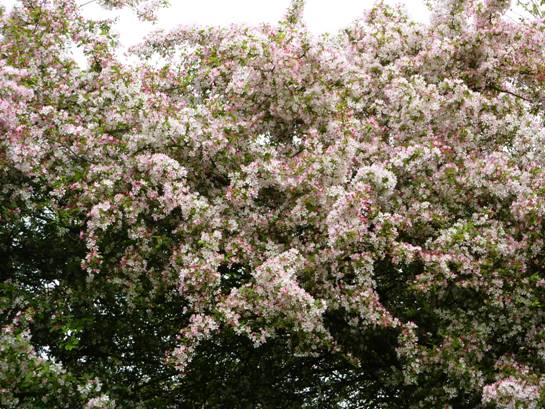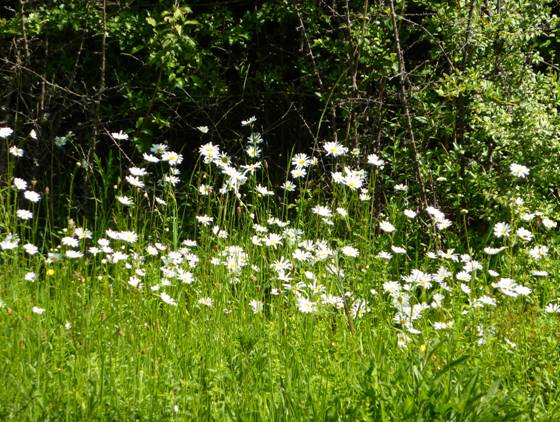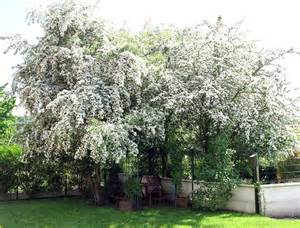
Salty Sam’s Fun Blog for Children
Number 105
Hedgerows
Hello Everyone

Welcome to my blog on its second anniversary! ![]()
![]()
Behind Rocky Bay there is a lot of farmland; a lovely place to go for walks.
When we go there we always keep to the lanes and foot paths and observe the country code.
Bill and Bob like going for walks and now that Emily has come to live in Rocky Bay she often comes with us too now.
There are many stone walls that border the fields and some of them are nearly 2,000 years old. But mostly what edges the fields and lanes are hedgerows.
Hedges were first planted in this country about 6,000 years ago. A lot of the ones we have now were planted up to 700 years ago and some are 1,500 years old (of course not all the plants are the original ones).
A lot of the hedges around here are planted on earth or stone banks.
Cornwall has the most ancient hedges in the country.
About one third of the trees in our hedgerows are over 100 years old now and more than half of the hedges are made from hawthorn. l have heard people say that you can tell when a hedge is old because it has a bigger variety of trees growing in it.
What you do is count the number of woody plant species in a 30 yard (27m) length of hedge. Each number represents one hundred years. So if you can see three species in that area the hedge is roughly three hundred years old.
lf the hedge only has hawthorn in it then it was probably planted in the 18th century – that means the 1700s.
Hedgerows are important to wildlife because they provide food and shelter. Half of our mammals live in them or travel along underneath them using them as protection, and many birds nest in them.
They harbour over 1,000 flowering plants, a lot of which feed butterflies and they are good places for high trees to grow to provide even more housing and food for animals.
Half our mammals live in them and almost all our birds like living in this kind of habitat. When a lot of our woodland was destroyed to make way for farmland and housing, this was the place many creatures retreated to.
Hedges also give shelter to farm animals who can tuck in beside them on a cold, windy day.
Miles of hedgerows have been removed in recent history, making what we have left even more valuable. Actually, about 300,000 miles of hedgerows have been lost since World War ll.
Some of the most beneficial trees in them are: oak, beech, hawthorn, hornbeam, birch and hazel.
ln fact, there is plenty of food to be found in hedgerows for humans too: blackberries, sloes, elderflowers and elder berries, rosehips, hazel nuts and sweet chestnuts. Elderflowers and elderberries have always been used to made wine and cordials. The flowers make white wine and the berries make red wine.
Remember though, you should never eat anything unless a grown-up is sure that it is alright to eat and they give you permission. You have to be careful; some berries like deadly nightshade are very poisonous.
One thing you can collect from hedgerows is rubbish (if other people are stupid enough to leave it around) because it is very dangerous to wildlife. Large animals can eat bits of plastic by mistake and smaller one like voles and shrews can slide down into cans or bottles accidentally whilst foraging for food. Because the insides are so tall and slippery they can’t climb out again! ![]()
Sometimes animals get their heads stuck in cans or bottles.
You can put these things into recycling banks – but always remember to wash your hands when you get home, better still wear gloves because you don’t want to cut your hands on broken glass or brambles.
lf you want to plant trees and plants to make a hedgerow, you can do it even if you don’t own vast tracts of land. Even a few plants can help wildlife. Birds that live in your garden hedge can eat the slugs and snails that eat your flowering plants and vegetables.
Good hedge plants to choose would be: berberis, brambles, buddleia, cotoneaster, crab apple, dogwood, holly, honeysuckle, ivy, old man’s beard, wild rose and spindle. You can even try growing some of these plants from seed.
Do you like watching wildlife in your garden?
Bye bye everyone – don’t forget to subscribe to my blog!
Love and kisses
Salty Sam

www.christina-sinclair.com

![]()

Bill and Bob’s Joke of the Week![]()
![]()
Bill: What goes all around a field but never moves?
Bob: l don’t know. What goes all around a field and never moves?
Bill: A hedgerow!

Salty Sam © Christina Sinclair 2015
Unauthorized use and/or duplication of material from this blog without express and written permission from this blog’s author and owner is strictly prohibited.
Links may be used to www.christina-sinclair.com


Picture Gallery

Hedgerows have many levels – tall trees, large and small bushes
and grasses and flowers at the bottom
 They provide food all through the winter
They provide food all through the winter

They provide berries even in the snow
 A hornbeam
A hornbeam
 A field maple has small leaves
A field maple has small leaves

Wild clematis and sloes which have black berries
 Crab apple blossom
Crab apple blossom
 Hawthorn blossom
Hawthorn blossom

Elder flowers turn into berries in the autumn
 Cow parsley growing on a roadside verge
Cow parsley growing on a roadside verge
 Wild flowers growing in the shelter of a hedgerow
Wild flowers growing in the shelter of a hedgerow

Buttercups can grow really tall in uncut grass
 Ox-eye daisies growing at the base of a hedgerow
Ox-eye daisies growing at the base of a hedgerow
 Never eat berries from a hedge when you don’t know what they are
Never eat berries from a hedge when you don’t know what they are
These privet berries are poisonous
 Robins are one of the birds that like nesting in hedgerows
Robins are one of the birds that like nesting in hedgerows

A dry stone wall means a wall built without any mortar sticking the stones together
 A hedgerow can become quite tall if not trimmed
A hedgerow can become quite tall if not trimmed
 Wild blackberries grow on brambles
Wild blackberries grow on brambles

Hawthorn blossom in the spring
 Hawthorn blossom usually comes out in May
Hawthorn blossom usually comes out in May
 Hawthorn berries
Hawthorn berries

Sloes
 Elderflowers
Elderflowers
 Elderberries
Elderberries
You won’t get any berries in the autumn if you pick all the flowers in the spring!

Rosehips – rich in vitamin C
 Hazel nuts
Hazel nuts
 Buddleia – also known as the butterfly bush
Buddleia – also known as the butterfly bush

Crab-apple – the fruits can be made into a jelly
 Honeysuckle smells very sweet
Honeysuckle smells very sweet
 The seeds of old man’s beard
The seeds of old man’s beard

A wild rose
 Spindle trees were used to make spindles for spinning wool
Spindle trees were used to make spindles for spinning wool
 The berries are supposed to make a good hair conditioner
The berries are supposed to make a good hair conditioner

Not everything found in hedgerows is to be picked –
the arum lily which produces bright seeds in the autumn that look like berries are very poisonous!
 This bear cub was rescued after 10 days of distress
This bear cub was rescued after 10 days of distress
![]()

 THE SALTY SAM NEWS DESK
THE SALTY SAM NEWS DESK

Emily is really settled into her new house now. The whole house has been decorated, the moving boxes have all been unpacked and the smell of paint has gone – but she hasn’t got out of the habit of going round to Auntie Alice’s house.
Auntie Alice always seems to be doing something interesting!
My Auntie Alice often makes jam in the summer and autumn and marmalade in the winter but she won’t let the children help because she says hot jam can splash and scald you.
But one thing she has taught the children to do is make jam tarts. They are a lovely excuse for playing with pastry and cookie cutters.
She gives them some left-over pastry to work with.

You can line baking/bun trays with thin circles of pastry and fill the cases with jam and then you can place a shape of pastry on the top to make them look more interesting.
This also works well with mince pies when a star on top of the sweet mince meat (and a sprinkling of icing sugar when they are cooled) makes them look very festive.
Or you could make savoury tarts too for tea or picnics.

NEWSDESK MINIMAKE
MUSHROOM QUICHES
If you are feeling very adventurous, fill the cases with a little fried onion and very thinly sliced mushrooms. Beat up an egg mixture with a splash of milk and a pinch of salt and pepper to top up the cases.
The quantities depend on how much pastry you have to work with.
Put a little grated cheese on the top and even inside the pastry when you are rolling it out if you like. (Keep your fingers well away from the sides of a grater when you are holding the cheese – graters can be sharp.)
Bake these mini mushroom quiches in a moderate oven for 15-20 minutes until the tops are golden brown.
Leave to cool on a wire rack.
*You may need an adult to help you deal with the stove and oven and knives.

If you would like to find out more about how you can help with the conservation of wildlife in hedges, check out hedgelink.org.uk.

Rubbish is dangerous to wildlife – it should be taken home and disposed of carefully!

Sock Appeal for Blue Cross Patients
Three weeks ago I put out an appeal for your used stamps, because charities can make money out of them.
This week I would like to tell you about another appeal.
The Blue Cross would love to have any baby socks that you don’t need anymore.
The vets use the little socks to keep the cats and dogs feet warm when they are having an operation. This helps them to get better more quickly.
Look on the Blue Cross website for more details…
Thank you

*********************
*********************


Crafty Tip
This is an easy pattern to knit a classy, sideways scarf for your twelve inch doll.


The rainbow yarn makes an interesting pattern and can look nicer than knitting it crossways.
Using 4mm knitting needles and dk rainbow yarn cast on 50 stitches
Garter stitch 6 rows and cast off

You can use the same pattern to knit a scarf for a child.
- Measure how long you would like it to be with a tape measure.
- Using long 4mm knitting needles cast on 2 stitches for every cm that you need.
- Knit until you reach the width you desire.
- lf you think you can’t manage this many stitches, you could choose to knit the scarf in two halves and have a join at the back of the neck.

![]()
BLOW MY FOGHORN!!!

PLUS
Salty Sam fans can join in with their comments and share them with children all over the world. You will need to ask permission if you are not an adult.
Enter your e-mail address to subscribe to my blog and receive new Salty Sam Blog Posts for free by e-mail every week. Your address will be kept private and will not be shared with any third party.
Sign me up at the side bar



![]()
lt’s the Weekend

HOW TO MAKE A ROUND EMBROlDERED BOX
You will need 3 plastic canvas circles 10.8cm/4.25 inches
A panel of plastic canvas 85 holes by 28 holes
A panel of plastic canvas 90 holes by 8 holes

The embroidered panel is created using lazy daisy stitch and French knots – make sure the embroidery will be the right size to fit the box lid.
The flowers don’t have to be all the same size; in fact they will look better if they are different sizes.

Draw your flower design onto a piece of paper to practise before you start sewing and then you will get a better overall design.
Cut one of the plastic canvas circles down by one line of holes and cover with the piece of embroidered fabric (cut the fabric larger than the plastic when you take it out of the embroidery hoop).
Pull the edges of the fabric around the plastic and using ladder stitch and strong thread pull tight.
Put a little stuffing in between the fabric and the plastic canvas before you ladder-stitch the fabric into place. Stitch it onto another of the canvas circles to hide the stitching at the back using tiny hem stitches with thread.

Cut down the third circle of canvas by 2 rows of holes and embroider with coloured rings (or one colour if you prefer) – this will be the base of the box.
The centre is white
1 row white
2 rows pink
2 rows white
2 rows mauve
2 rows white
2 rows green

Cover the rectangular panels with Norwich stitches of different sizes and in random order to create a stone wall effect but leave 5 rows of holes empty one end of the larger piece to make an overlap when you are sewing up the box (a strip 28 x 5).

Norwich Stitch/Southern Cross
Bring the needle up on the odd numbers and pass down on the even
|
4 |
12 |
20 |
28 |
21 |
13 |
5 |
2 |
|
7 |
10 |
||||||
|
15 |
18 |
||||||
|
23 |
26 |
||||||
|
22 |
27 |
||||||
|
14 |
19 |
||||||
|
6 |
11 |
||||||
|
1 |
9 |
17 |
25 |
24 |
16 |
8 |
3 |
|
4 |
12 |
20 |
13 |
5 |
2 |
|
7 |
10 |
||||
|
15 |
18 |
||||
|
14 |
19 |
||||
|
6 |
11 |
||||
|
1 |
9 |
17 |
16 |
8 |
3 |
Fill in the gaps between the squares with diagonal stitches to represent the mortar.
- To construct the box; sew the sides to the base and sew up the side seam tucking the 5-hole overlap inside – use over-sew stitches in white yarn
- Over-sew the rim of the box
- Run a line of little white back stitches around the outside of the daisy panel
- Sew the top of the lid to the sides of the lid – use over-sew stitches in pink yarn
- Butt the edges of the sides of the lid and use over-sew stitches to secure them together and continue to sew around the rim of the base of the lid in white yarn

- Cut panels of fabric to match all the embroidered pieces adding a 1cm/½ inch seam allowance in every direction (2 circles, a rectangle and a strip)
- Make up a fabric box base and attach the top edge to the top edge of the box base and a fabric lid and attach the base to the base of the box lid (tucking the raw edges inside between the two surfaces) using white sewing thread
You can use your box for storing, cotton wool balls, buttons, etc.


Please note that the material on this blog is for personal use and for use in classrooms only.
It is a copyright infringement and, therefore, illegal under international law to sell items made with these patterns.
Use of the toys and projects is at your own risk.
©Christina Sinclair Designs 2015
![]()
Embroidery Stitches




You are a great writer!
Thank you Cherry!